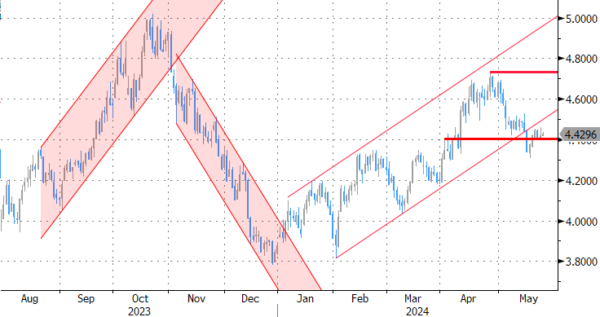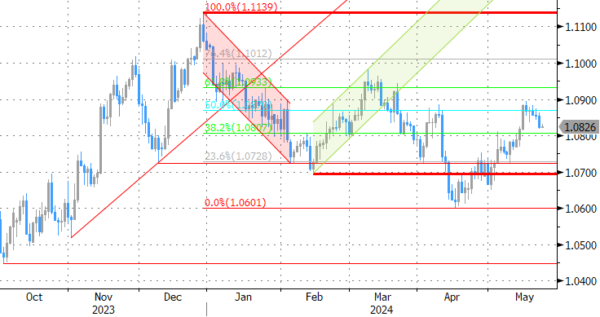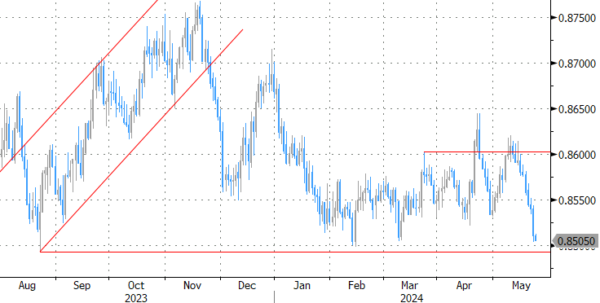Markets
Above-consensus April inflation figures in the UK triggered an obvious underperformance of gilts, resulting in yield gains between 7.2 (30-yr) and 14.2 bps (2-yr). A June rate cut by the BoE is just short of fully priced out. Steep gilt losses dragged core peers lower as well. German yields gapped higher at the open and traded sideways afterwards. Yields ended between 2.7 and 4 bps higher across the curve. US rates at the front rose up to 4.2 bps after receiving a second gentle push in the back by the FOMC May meeting minutes. They generally showed policymakers supporting a higher for longer message in the wake of “disappointing readings on inflation over the first quarter”. “Various” participants mentioned willingness to tighten further if needed, something chair Powell at the press conference more or less ruled out. While he said back then that policy was restrictive enough, the minutes revealed more uncertainty with officials pointing at the possibility of high interest rates having a smaller impact on the economy than in the past and a potentially higher neutral rate. The dollar gained the upper hand all day against most peers, supported by the minor risk-off on equity markets (WS between 0.2 and 0.5% lower). EUR/USD fell from 1.0854 to 1.0823 with a noticeable acceleration after the minutes’ release. DXY closed a tad below 105, up from 104.618 at the open. USD/JPY (156.8) closed at the highest level since the (alleged) intervention by Japanese officials. Sterling shared first place with the NZD (hawkish hold by the RBNZ). EUR/GBP tanked towards the lowest level since mid-March. With a close at 0.851 the pair seems to be reading a test for the YtD low of 0.8498. Cable (1.2717) eked out a small again despite an overall strong USD.
PMI business confidence and euro area Q1 negotiated wages are the next big thing on this week’s economic calendar. Markets are headed towards their release expecting an ongoing recovery of the former in Europe. Especially services (53.3 in April) surprised to the upside lately, with even final readings coming in better than the preliminary release. Manufacturing will remain in the doldrums, weighed down by Germany in particular. Last time around, though, the rate of decline in the actual output eased again to the slowest in 12 months. Price pressures have been intensifying in recent months with prices in services climbing at a strong pace by historical standards, driven by higher wage rates. This is where the Q1 wage negotiations outcome will offer an important glimpse for what to expect going forward. Member states data suggest only a marginal easing of the 4.5% pace in 2023Q4. Taken together, we believe today’s data will support core/European yields in their recent recovery. This should protect the euro’s downside against a dollar that did notice yesterday’s FOMC meeting minutes and Powell’s one-sided interpretation at the presser. A break above the recent highs (1.0895) requires a strong upside surprise in both the PMIs and the wage data.
News & Views
UK PM Rishi Sunak yesterday called a July 4 general election. The move came as a surprise as the Conservatives trail the opposition Labour party led by Keir Starmer by some 20 points in the polls (roughly 45% vs 25%), likely ending their 14-yr rule in power. There was no point in waiting until autumn though. After consulting with Chancellor Hunt, they agreed there won’t come any additional economic cheer, not least because public finances don’t allow for more tax gifts. It could help them campaigning on the swift recovery from recession and the fall in inflation (2.3% headline) given the bumpy path ahead. The Tories faced a hard January 2025 deadline nevertheless to hold new elections.
The Bank of Korea kept its policy rate unchanged at 3.5% this morning, the level in place since January 2023. The decision was unanimous. The central bank raised its growth forecast for this year from 2.1% to 2.5% and lowered it from 2.3% to 2.1% for next year. This year’s CPI forecast is unchanged at 2.6%, but more data is needed to be confident that inflation will converge to the target given increased upside inflation risks (stronger Q1 growth, heightened volatility in the exchange rate and persisting geopolitical risks). Governor Rhee Chang-yong at the press conference sounded less certain on the timing of a potential first rate cut than a month ago.
Graphs
GE 10y yield
ECB President Lagarde clearly hinted at a summer (June) rate cut which has broad backing. EMU disinflation continued in April and brought headline CPI closer to the 2% target. Together with weak growth momentum, this gives backing to deliver a first 25 bps rate cut. A more bumpy inflation path in H2 2024 and the Fed’s higher for longer strategy make follow-up moves difficult. Markets have come to terms with that.
US 10y yield
The Fed in May acknowledged the lack of progress towards the 2% inflation objective, but Fed’s Powell left the door open for rate cuts later this year. Soft US ISM’s and weaker than expected payrolls supported markets’ hope on a first cut post summer, triggering a correction off YTD peak levels. Sticky inflation suggests any rate cut will be a tough balancing act. 4.37% (38% retracement Dec/April) already might prove strong support for the US 10-y yield.
EUR/USD
Economic divergence, a likely desynchronized rate cut cycle with the ECB exceptionally taking the lead and higher than expected US CPI data pushed EUR/USD to the 1.06 area. From there, better EMU data gave the euro some breathing space. The dollar lost further momentum on softer than expected early May US data. Some further consolidation in the 1.07/1.09 are might be on the cards short-term.
EUR/GBP
Debate at the Bank of England is focused at the timing of rate cuts. Most BoE members align with the ECB rather than with Fed view but slower than expected April disinflation complicated matters. A June cut looks in line with the ECB looks improbable. Sterling extends a recent bull rally. A test of EUR/GBP’s 2024 YtD low (0.8489) is possible. We expect this important support level to hold.
















